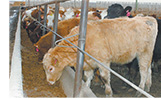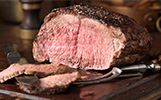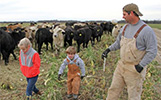| Roughage Reduces Abscesses, But Is It Cost Effective?
Western Producer (subscription) | February 5, 2016
Liver abscesses negatively affect profitability at the individual animal level, but an Alberta veterinarian says there can be a surprisingly positive correlation at the population level.
Dr. Eric Behlke of Feedlot Health Management Services in Okotoks, Alta., said a 2014 study of 837,405 head slaughtered in Alberta found that two percent of the cattle had severe liver abscesses, three percent had minor abscesses and 95 percent were clear.
Input Sought from Beef Producers
Monica Lamb–Yorski, Williams Lake Tribune | February 9, 2016
Beef producers are being asked to give input on the Canadian Roundtable for Sustainable Beef's (CRSB) first draft of its sustainability "indicators" for beef operations. "For some time our roundtable has been committed to developing a framework," said Monica Hadarits, community engagement manager with CRSB. "This is the first time we are going out to the public with a 60–day consultation period." All comments will be reviewed, and a written response to each comment will be posted on the organization's website following the consultation.
Russia Signs Meat Deal with Uruguay
Vladislav Vorotnikov, GlobalMeatNews | February 12, 2016
Uruguay will supply Russia with high–quality beef, following the recent agreement to reduce import tariffs. The deal comes after three years of negotiations and is expected to significantly boost Uruguayan export of beef to Russia. The issue of FMD vaccination could significantly constrain the export potential of Uruguay's beef industry to Russia, but according to a recent report from the Agricultural Ministry, Russia currently imports 80–90% of its breeding cattle, so Uruguay could benefit in this area.
Could CSIRO Redeployments Kickstart Australian Innovation?
Mick Keogh, Beef Central | February 12, 2016
The proposed redeployment of CSIRO staff from climate modelling to other areas with a focus on encouraging national innovation needs to be considered with the above issues in mind. It also needs to be considered against a backdrop of there being at least fifty major programs underway around the globe to develop and refine global climate models, many of these in nations with much larger science budgets that Australia.
Beef Battle: Proposed State Beef Checkoff Draws Mixed Responses
Trevor McDonald, Hannibal Courier–Post | February 12, 2016
A statewide proposal for a new beef checkoff is drawing mixed responses from beef producers and farmers groups as the referendum for the measure draws near. Missouri beef producers will have the chance to vote for a state beef checkoff — a $1 fee that is charged per head of cattle — in April. Beef producers already pay the same amount for a federal checkoff fee. Supporters said the state proposal will boost market development, research and advertising efforts within the beef industry, strengthening the market as a whole and providing customers with the beef products they liked best.
TPP Would Be 'Death Knell' for Industry, R–CALF Leader Says
Capital Press | February 18, 2016
Under TPP, meat packers could slaughter foreign–sourced beef in the United States and have it be considered a U.S. product, shipping it to other countries duty–free, said Bill Bullard, CEO of R–CALF in Billings, Mont. R–CALF represents independent cattle producers.
"The TPP is a license for the multi–national meat packers to steal from you, your good name, your image, your reputation and affix your good name, image and reputation on beef from animals sourced anywhere in the world with a USA label," Bullard said.
Will The Trans–Pacific Partnership Rally Cattle Markets?
Wyatt Bechtel, Drovers CattleNetwork | February 5, 2016
Trade has been top of mind for beef producers this past year as export volumes dropped and cattle prices have fallen. A rally could be around the corner with the Trans–Pacific Partnership (TPP) being signed by 12 member countries on Thursday. The trade agreement might be one of the biggest opportunities to turn–around a sliding cattle market.
Hungry Jack's Hormone–Free Burgers – Is It a Ploy? 
Anthony Colangelo, The New Daily | February 16, 2016
Fast food franchise Hungry Jack's has announced its beef patties will be produced without added hormones, but livestock and science experts have doubted the motives of the burger giant. On Tuesday, Hungry Jack's revealed that it would no longer sell beef given Hormone Growth Promotants (HGP), but it might be little more than a marketing ploy.
Food Standards Australia and New Zealand (FSANZ) listed HGP as the "naturally occurring" hormones trenbolone, oestrogen, progesterone and testosterone, which are injected into local cattle. "HGPs are used safely in Australia," FSANZ said. "The hormones come in small implants placed under the skin on the back of the ear, slowly releasing a low dosage, usually over 100 to 200 days, depending on the product used."
How Ethiopia Can Overcome the Worst Drought in 50 Years 
Daniel Speckhard, Time | February 11, 2016
In the West you can hear a collective groan: Not Ethiopia again. The news coming out of the East African nation is of theworst drought in 50 years.
Fortunately, this is no rerun of the 1983–85 famine that gave us the Live Aid benefit concert for the country, which elevated famine to the international stage and screen and helped secure humanitarian aid. Far more than the music industry has invested in Ethiopia since then, including the U.S. government, helping Ethiopia make impressive strides in fighting poverty, fostering economic growth and improving infrastructure.
Unfortunately, Ethiopia's current crisis threatens to obscure news of its impressive growth..
Treating Cover Crops Like Cash Crops 
Chris Bennet, Drovers CattleNetwork | February 9, 2016
Initially planting cover crops solely for erosion protection, Taylor transitioned to soil health covers, and recently to grazing covers in tandem with cattle rotation. On Taylor's ground in Phillips County, Ark., livestock are the vehicle to building higher potential soils.
| |
